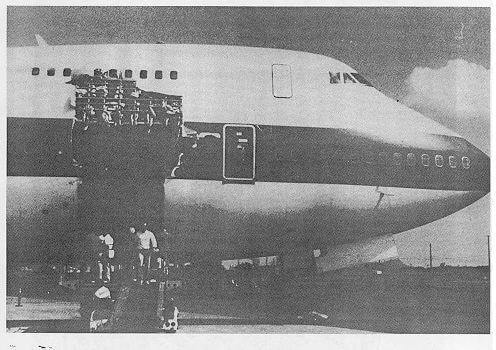February 24, 1989. United Airlines Flight 811 departs Honolulu, Hawaii at 01:52:49 (HST) routing to Sydney, Australia via Auckland, New Zealand. The flight was served by a Boeing 747-100 with 337 passengers, three flight crew and 15 cabin crew on board for the sector between Honolulu and Auckland.
The routine flight was on departure from Honolulu and began climbing to its cruise altitude. As the aircraft climbed through 22,000ft, there was a loud thump, which shook the airplane. This was immediately followed by an enormous explosion.
The flight crew donned oxygen masks but found no oxygen available. The cabin altitude horn sounded, indicating a loss of pressure and it was assumed the passenger oxygen masks had deployed.
The Captain immediately initiated an emergency descent and turned back to Honolulu. The First Officer began declaring an emergency, squawking 7700, followed by the shutting down of the No.3 engine due to vibration.
The Second Officer left the flight deck to inspect the cabin and returned to inform the Captain that a large part of the cabin fuselage was missing. Inside the cabin, it was total darkness, accompanied by the deafening noise.
Additionally, the No.4 engine had to be shut down and fuel dumping was initiated to reduce the plane’s weight and allow for a safer landing.
The Crew made the approach with only the left two engines functioning and landed back at Honolulu at 02:34 (HST). As the aircraft came to a halt, an emergency evacuation commenced on the runway.
The devastation of the explosive decompression soon became clear. The cargo door was missing and there was a gaping hole in the aircraft fuselage measuring 13 feet wide by 15 feet tall. There was significant damage to the airframe and engines cause by the debris, which punctured and dented various parts of the right wing, the vertical and horizontal stabilizer as well as the No.3 and No.4 engines.
Inside, the cabin floor structure had caved in, and the oxygen supply lines for both the flight deck and the cabin had been severed.
Most tragically of all, during the decompression nine passengers seated in the lower business class forward section seats 8H, 9FGH, 10GH, 11GH and 12H were ejected from the fuselage.
What went wrong?
Despite extensive searching following the accident, the cargo door was not found. The National Transportation Safety Board (NTSB) investigation therefore relied on similar incidents that had previously occurred.
Based on tests by Boeing and evidence from a 1987 incident involving a Pan Am Boeing 747 cargo door, the NTSB report concluded that the door might have appeared closed and locked when in fact it was not fully latched, leading to the inflight separation and decompression.
Further Investigations
But this was not the end of the investigation. Lee Campbell was one of the fatalities on Flight 811. He was just 24 years old. His parents, Kevin and Susan Campbell, began their own investigation into Lee’s tragic death.
They obtained documents from the NTSB and came to their own conclusion that the accident was most likely caused by the design of the 747 cargo door latching mechanism, which, using weak aluminum locking pins, could not prevent the locks unlatching in the event of a short circuit.
By October 1, 1990, two halves of the cargo door were recovered from the Pacific Ocean at a depth of 14,200 feet. The NTSB inspected the door and subsequently determined that the findings did not support the original investigation report.
In 1992, the NTSB published a new accident report for Flight 811.
“The door opening was attributed to a faulty switch or wiring in the door control system which permitted electrical actuation of the door latched toward the unlatched position after initial door closure and before takeoff,” the report stated.
The report also detailed “a deficiency in the design of the cargo door locking mechanisms which made them susceptible to deformation” as well as “a lack of timely corrective actions by Boeing and the FAA following a 1987 cargo door opening incident on a Pan Am B-747”.
Outcomes
After the Pan Am incident and its subsequent investigation, the Federal Aviation Authority (FAA) issued an airworthiness directive to airlines in July 1988, stating the need to replace the aluminum locking pins with steel. The FAA also stated that airlines were required to carry out various inspections. At the time, airlines were given 18-24 months to comply.
However, in 1992, following the final NTSB report into United Airlines Flight 811, the FAA shortened this requirement to 30 days.
The crew members of flight 811 were highly praised for their respective efforts in dealing with the incident and for the skill shown in handling the aircraft and returning it to Honolulu for a safe landing. The efforts of the cabin crew, who overcame the challenges brought throughout the difficult flight and oversaw the successful evacuation of the aircraft were also commended.
Sadly, the bodies of nine passengers who were swept from the aircraft during the decompression were never found and were presumed to be lost at sea

